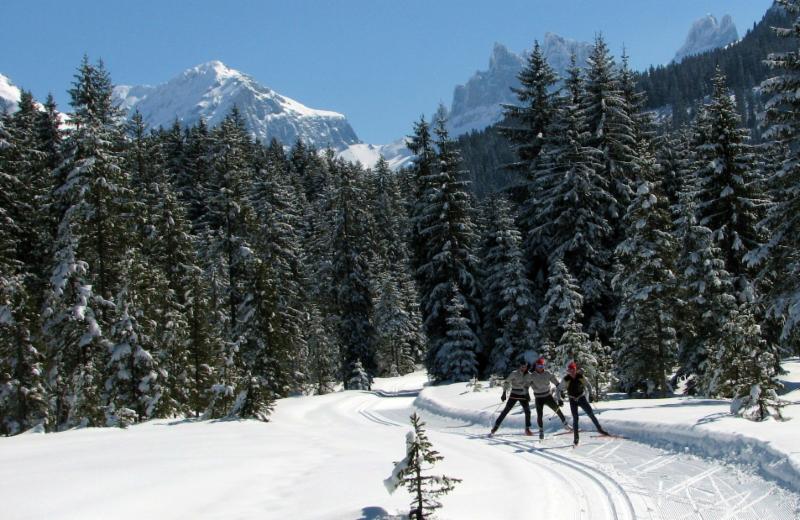
A training recommendation for Master Skiers specifically
Tue, Nov 6, 2018 - By Ian Harvey
This recommendation is specifically meant for master skiers. One thing that I have noticed when out skiing is that most master skiers seem to go out and ski "at their pace", which is generally medium-hard, for their workout and then go home. They then repeat this every time they ski. The question that I have for those who are doing this is if you are happy with your overall ski experience or would you like to be faster and have a more diverse skiing experience? Some might simply answer, "I'm happy doing it this way even though I understand that it won't make me faster or fitter". If that's the case, then of course there's not much more to say except for "enjoy!"
This practice of doing the same medium-hard type thing every day yields basically no improvement at all and overall is an extremely poor training plan if the goal is to become a faster fitter easier skier. Furthermore based on what I have seen, most skiers generally ski this way to fatigue in an effort to get the most out of their workout. This also leads to overtraining symptoms and injury despite the fact that the potential reward for this training activity is very low. (In the risk reward ratio, this type of training is high risk and low reward).

When training is differentiated each day such that different systems are worked, the benefits become readily apparent. Generally doing this brings more satisfaction, the skier feels better in general with more energy and less fatigue, and there is a clear marked improvement when compared to the "every day medium-hard model".
Everyone trains different amounts, but as a general rule, if a person is trying to get faster, there should be a workout that involves intervals (intensity), another with specific strength (such as skating without poles, double poling, etc.) or sprints (multiple 15 second bursts that not only give an athlete speed and coordination, but also is a superb specific strength workout), and workouts that are long and slow which are designed to improve efficiency. Let's say one intensity workout and one sprint/strength workout a week are done. Sometimes another intensity workout would want to be added but otherwise, the rest of the workouts should be long and easy. I think we are all pretty good at designing intensity workouts and strength/speed workouts. It seems to me that we are really bad at planning and executing long easy workouts as strange as that might sound. I say this based on my observation of master skiers throughout the winter.
I recommend using a heart rate monitor. Try your best to determine your maximum heart rate. Within the realm of master skiers, I have found that max heart rates can vary greatly. Also, if a skier only does long slow distance training, the max heart rate will be very low compared to after the same athlete does a couple months of hard intervals which will restore the body's ability to go hard. This means that, depending on what the skier is doing for training, the max heart rate is not a static number, but needs to be reevaluated now and then.
Set your heart rate monitor to beep if you are going harder than you should. For a long easy workout (any type) I would recommend making about 70% of your max heart rate the ceiling for your long easy workouts (when your monitor beeps telling you to slow down). Pretty much all heart rate monitors enable you to look at your average heart rate at the push of a button during the workout. I monitor this with the goal of keeping my average heart rate at 65% of my maximum heart rate or below. These numbers can be tweaked a bit, but this is the idea. I will go out for a ski or hike with the goal of finishing with my average heart rate below 110 bpm. When I do that, I find that I get everything out of the workout that I was looking for (a training effect that makes me more efficient) and a pleasant experience, but not what I wasn't looking for (a build up of fatigue). This also makes it possible for people to visit and have nice conversations when doing long easy workouts. This is the way it is supposed to be for us master skiers. The hammerfests should be the exception.

During the dry land training season, for master skiers, I absolutely recommend that the activity for these long easy workouts is not skiing (classic or skate rollerskiing). I think they should be running, cycling, or hiking. For master skiers to do these workouts on rollerskis means to either go too hard or to ski with poor technique. By poor technique I mean your technique will become very efficient at slow speeds (i.e., no weight shift, leaning over on a straight leg, etc.) and when you try to ski fast again, your technique will impede you greatly. In the winter, you can do these workouts on skis, but find very easy terrain so you can ski with clean technique without going too hard. Save the harder terrain for your harder workouts.
If these very basic training principles are adhered to, it will greatly benefit the skiers' overall experience if they are looking to feel better during and after workouts, have more fun and satisfaction from skiing, get faster, and feel healthier. Good luck!
[This article by Toko's Ian Harvey can also be found in the Master Skier. What, you don't get the Master Skier? Sign up with AXCS (American Cross Country Skiers) and get the annual Master Skier magazine, sprint and summer issues of the AXCS XC Ski Digest, email newsletters more exclusive articles specific to adult skiers from novices to experts from around the XC world...and more! https://www.xcskiworld.com/about]
